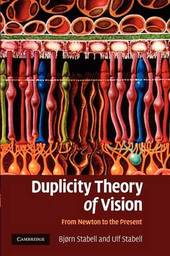
|
Duplicity Theory of Vision: From Newton to the Present
Paperback / softback
Main Details
| Title |
Duplicity Theory of Vision: From Newton to the Present
|
| Authors and Contributors |
By (author) Bjorn Stabell
|
|
By (author) Ulf Stabell
|
| Physical Properties |
| Format:Paperback / softback | | Pages:238 | | Dimensions(mm): Height 229,Width 152 |
|
| Category/Genre | Physiology
Neurosciences
Human biology |
|---|
| ISBN/Barcode |
9781107412842
|
| Classifications | Dewey:612.84 |
|---|
| Audience | | Professional & Vocational | |
|---|
|
Publishing Details |
| Publisher |
Cambridge University Press
|
| Imprint |
Cambridge University Press
|
| Publication Date |
17 January 2013 |
| Publication Country |
United Kingdom
|
Description
The duplicity theory of vision concerns the comparisons (both differences and similarities) and interaction between the cone and rod systems in the visual pathways, with the assumption that the cone system is active during daylight vision and the rod system functions in low light (night time). Research on this aspect of vision dates back to the 17th century and the work of Newton, and is still ongoing today. This book describes the origin and development of this fundamental theory within vision research - whilst also examining the Young-Helmholtz trichromatic colour theory, and the opponent colour theory of Hering - and presents evidence and ideas in light of modern conceptions of the theory. Written for academic researchers and graduate students, the book brings back knowledge of the tradition of duplicity theory, inspiring questions related to anatomy, comparative biology, molecular biology, photochemistry, physiology, genetics, phylogenetics and psychophysics.
Reviews"Duplicity Theory of Vision presents a comprehensive and detailed account of an important area of research in vision. The text is well written and organized in a manner that is accessible for the degree of technical material that is presented. I recommend it to those who are primarily interested in a historical account of vision research." Paula Goolkasian, PsycCRITIQUES
|